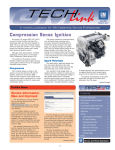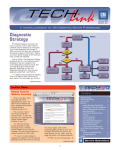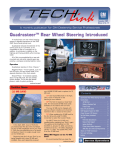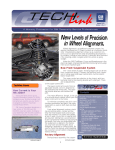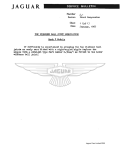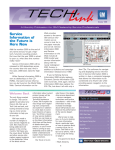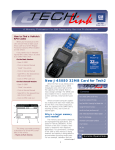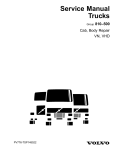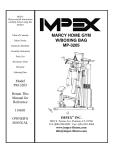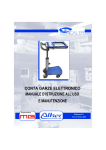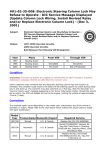Download Dealing With Battery Parasitic Drains
Transcript
April 2002 Volume 4, No. 4 A monthly publication for GM Dealership Service Professionals Dealing With Battery Parasitic Drains In automotive terms, a parasitic drain is an electrical load that draws current from the battery when the ignition is turned off. Some devices, such as the PCM and radio memory are intended to draw a very small amount continuously. These draws are measured in milliamps (mA). In normal use, parasitic drains aren’t usually cause for concern, because the battery is replenished each time the vehicle is driven. But, in long-term parking situations, parasitic drains may discharge the battery enough to cause a no-start condition. New vehicles in dealer stock and airport long-term parking are two such situations. An abnormal parasitic drain could be a glovebox or luggage compartment light that remains on but undetected. Or an electronic component may malfunction and cause a parasitic drain that is larger than normal specification. continued on page 3 Techline News Tech 2 EVAP Service Bay Test Re-enabled For many years, emission regulations have required an on-board system to trap fuel vapor from entering the atmosphere. Even a very small leak in the EVAP system could allow vapors to escape. So, on-board leak detection is an important function of the EVAP system. Government requirements sometimes change; this has happened to EVAP regulations. Currently, the on-board diagnostics must be able to detect a leak as small as 0.020-inch (0.51 mm). The Tech 2 EVAP Service Bay Test is useful because it can tell the PCM to run the onboard diagnostic EVAP tests with slightly relaxed cold-start enable criteria. Because a complete cold start is not required, EVAP system testing and/or repair verification runs more quickly, including setting the readiness “flag” used for I/M testing in certain areas of the country. TIP: The J-41413-200 Evaporative Emission System Tester (”smoke machine”) was described in the November 2001 TechLink. It helps locate leaks and confirm Contents repairs. However, it will not reset the readiness “flag” in the PCM. It was discovered that the Tech 2 EVAP Service Bay Test did not accurately reflect what was going on in certain vehicles equipped with V6 and premium V8 engines. So, for a while, the EVAP Service Bay Test was disabled in Tech 2 software for these vehicles. Now that the situation has been studied and better understood, the EVAP Service Bay Test is being re-enabled for a number of these vehicles. The Tech 2 software contained on CD 3 for 2002 includes this change. This programming is also included in the current TIS 2000 update broadcast through the GM ACCESS satellite. We've covered only the highlights here. This is a somewhat complicated issue, so be sure to read the upcoming Bulletin 02-06-04-014, which will list those vehicles that will remain disabled. Dealing with Battery Parasitic Drains . . . . . . . .1 Tech 2 EVAP Service Bay Test Re-enabled . . . . .1 Midtronics Micro 411 Battery Tester Update . . .2 Class 2 Corner . . . . . . . . . . . . . . . . . . . . . . .2 Diagnostic Strategy Update . . . . . . . . . . . . . . .3 Rear Fog Lamp Bulb Life . . . . . . . . . . . . . . . . .3 Theft Deterrent Application and Programming . . .4 Clunk During a Turning Maneuver, part 2 . . . . . .5 Power Sliding Door Recall Clarification . . . . . . . .5 Tracker Roof Rack Cross Rail . . . . . . . . . . . . . .5 Door Glass Sash Panel . . . . . . . . . . . . . . . . . .5 Avoiding Damage to Steering Column Parts . . . .5 Repair Order Documentation . . . . . . . . . . . . . .6 New Transmission Return Form . . . . . . . . . . . .7 New Information-Only Prompt at TAC . . . . . . . . .7 Bulletins . . . . . . . . . . . . . . . . . . . . . . . . . . . .8 – Thanks to Mark Potter and Steve Abbosh Service and Parts Operations 1 Midtronics Micro 411 Battery Tester Update The J-42000 Midtronics Micro 410 battery tester was introduced in 1998. It provides a convenient alternative to the traditional battery load test and is also capable of testing batteries with a low state of charge. If you purchase the new tester and the optional printer, they are packaged in a convenient plastic storage case. The new J-42000-EU will replace the original model in the Kent-Moore catalog, so if you purchase a new one, it will have the updated features. Tips for Using the J-42000-EU Tester Effectively When using the J-42000-EU (or the original J-42000), be sure to get good connections at the battery. In the vehicle, make sure the battery terminals and cables are clean and tight. A revised Micro 411 tester, the J-42000-EU, is now being released as a running change. Features of the New J-42000-EU The software in the new J-42000-EU has a built-in AGM prompt. This eliminates the need to add 100 to the battery’s CCA when testing AGM (absorbent glass mat) batteries, as required by the original tester. Another software difference is noticed when performing an in-vehicle test. If the battery tests “good,” the diagnostic code appears. But if a “replace battery” readout appears, you must first run an out-of-vehicle test before the diagnostic code is displayed. The J-42000-EU is equipped with an infrared port, which transmits data to an optional cordless thermal printer, J-42000-20. The printout includes the last four digits of the VIN, and may be attached to the repair order as additional documentation of the diagnostic code and the battery’s test condition. You may also want to provide a copy to the customer. The Class 2 Message Monitor provides two features that allow the Tech 2 to send a wake-up message to the controllers on the Class 2 bus. They are "Ping" and "Ping All". These modes allow you to watch the response of a controller when the ping message is sent. The difference between Ping and Ping All is simple. If you want to send a wake-up message to all controllers on the bus, press the "Ping All" softkey. If you want to concentrate on just one controller, highlight the controller and press "Ping". The test is run with the Tech 2 in Class 2 Message Monitor mode with the ignition off, Make sure both jaws of each test clamp are making good connection. Each jaw is wired to a different part of the tester and both are essential. Be sure the ignition and all accessories are turned off. TIP: When using the original J-42000 only, you must add 100 to the battery’s posted CCA rating if you are testing an AGM battery (August 2000 TechLink). A special tag with this information was sent out to be attached to your J-42000. GM TechLink is a monthly magazine for all GM retail technicians and service consultants providing timely information to help increase knowledge about GM products and improve the performance of the service department. This magazine is a companion to the GM Edge publication. Publisher & Editor: Mark Stesney GM Service Operations [email protected] Technical Editor: Jim Horner [email protected] 1-248-816-3641 Production Manager: Marie Meredith Desktop Publishing: Greg Szpaichler, MediaWurks [email protected] FAX number: 1-248-649-5465 Before condemning a battery as bad, always perform an out-of-vehicle test with the battery terminal adaptors properly attached to the battery. Using bolts or unapproved adaptors can lead to failing batteries that are not defective. Write to: TechLink PO Box 500 Troy, MI 48007-0500 TIP: The GM p/n 12303040 terminal adaptor is the ONLY acceptable substitute to the one that comes with the tester. GM TechLink on the Web: http://service.gm.com Record the test code on the repair order. This is necessary for continuing product improvement. – Thanks to Dave Roland and Charley Gipe General Motors service tips are intended for use by professional technicians, not a "do-it-yourselfer." They are written to inform those technicians of conditions that may occur on some vehicles, or to provide information that could assist in the proper service of a vehicle. Properly trained technicians have the equipment, tools, safety instructions and know-how to do a job properly and safely. If a condition is described, do not assume that the bulletin applies to your vehicle or that your vehicle will have that condition. See a General Motors dealer servicing your brand of General Motors vehicle for information on whether your vehicle may benefit from the information. Inclusion in this publication is not necessarily an endorsement of the individual or the company. so all the controllers are showing Inactive. After pinging, the controller should respond by becoming "Active" for a short time, then return to Inactive, assuming no other inputs such as ignition-on are received. TIP: Not all controllers will respond to the "Ping" command. It will be necessary to try this on a known-good vehicle to determine the correct response from the controllers before you can make any conclusions about a suspect controller on the vehicle being worked on. Copyright© 2002 General Motors Corporation All rights reserved. – Thanks to Mark Harris 2 Return to page 1 Dealing with battery parasitic drains Parasitic Drains and Onthe-Lot Battery Discharge TIP: In most cases of discharged batteries in low-age, low-mileage vehicles, proper charging procedures with approved charging equipment is the only repair necessary. Here are some rules of thumb that might help relate parasitic drains to how long a battery would last on a parked vehicle. The Reserve Capacity (RC) rating multiplied by 0.6 gives the approximate available ampere-hours (AH) from full charge to complete run-down. Somewhere between full charge and complete rundown, the battery will reach a point at which it can no longer start the engine, although it may still operate some of the electrical accessories. Using up about 40% of the total available AH will usually take a fully-charged battery to a no-start condition at moderate temperatures of 77°F (25°C). Put another way, for a typical battery in a storage situation, depleting the available AH by 20 to 30 AH will result in a no-start condition. TIP: If the battery begins storage at 90% of full charge, reduce the available AH accordingly. The recommendation for maximum parasitic drain is around 30 mA (0.030 amps). A typical drain today actually falls into the 7 – 12 mA range, even though some vehicles do approach the maximum. Multiply the drain (in amps) by the time (in hours) the battery sits without being recharged. The result is the amount of AH consumed by the parasitic drain. The actual drain may be small, but over time the battery grows steadily weaker. Here’s an example. A vehicle with a 30 mA drain and a fully-charged 70 RC battery will last 23 days. But if that battery is at only 65% of full charge (green dot barely visible), it is going to last only 15 days before causing a no-start. The Effects of Temperature on a Standing Battery The parasitic drain will be fairly constant over a range of temperatures. The important temperature is that of the vehicle at the time a start is attempted. Colder temperature raises the threshold of a no-start by increasing the residual power needed. When the temperature falls to 32°F (0°C), the battery will be able to put out only about 85% of its normally-available starting power, and the engine may need as much as 165% of the usual power to start. The combined effect of these two factors is to reduce the number of days the battery can stand with a parasitic drain. At 32°F (0°C), the battery can stand only half as long as it could at 77°F (25°C). And at 0°F (-19°C), the standing days are reduced to one-fourth. Temperatures above a moderate climate of 77°F (25°C) increase the battery's internal continued from page 1 self discharge. If the battery is in a locale where the temperature is averaging 90°F (32°C), an additional 5% to 10% of the available ampere-hours will be lost in a month due to self-discharge within the battery. At temperatures below the moderate range, self discharge will be low enough to be negligible compared to the parasitic loss. What the Policies and Procedures Manual Says About Parasitic Drains Because determining how long a battery may last in a storage situation is not precise, the P&P manual provides a clearcut policy, excerpted here. “Discharged batteries can freeze at temperatures as high as 32°F (0°C), causing permanent damage. Other permanent damage may result from allowing batteries to stand discharged for extended periods. “To alleviate this condition, the negative battery cable should be disconnected on vehicles which are not going to be in service within a 20 day period, beginning from the time the vehicle is shipped. If this is not possible, batteries should be recharged periodically, every 20-45 days, until the green eye is visible. “Disconnected batteries will slowly discharge, especially with higher temperatures; therefore, even disconnected batteries should be checked for a green eye every four months and recharged if necessary. “Vehicles on display are subject to battery discharge due to drains from courtesy lights and other accessories. Provision to maintain battery state of charge for these vehicles will be necessary.” must be run and all accessories must be operated as instructed. After shutting the ignition off, turn the test switch off. Now, all current being used by the vehicle is shunted through the ammeter where it is measured. If the reading is out of specification, the procedure explains how to pinpoint the cause. Finally, a Word About Battery Testing Your dealership has an essential tool, Midtronics Micro 410 Battery Tester J-42000. Use it to quickly identify batteries that are serviceable and can be charged. There is information about this tool in bulletin 99-06-03-012. There was an article about this tester in the May 2000 issue of TechLink, and there’s an update on page 2 of this issue, covering the newly-revised Micro 411 tester J-42000-EU. – Thanks to Rick Overman and Dave King Rear Fog Lamp Bulb Life Some customers who leave the rear fog lamps on all the time, on a 20012002 Oldsmobile Aurora, may comment that the bulb life appears short. A Sylvania 921LL extended life bulb is available from GMSPO. The GM part number is 22692679. – Thanks to Ian Doran Consult your P&P manual for full details. Tracking Down the Source of a Parasitic Load If the battery in a vehicle becomes discharged in a shorter time than described earlier, the vehicle may have an out-ofspecification parasitic load. SI 2000 contains procedures for locating parasitic loads. Here’s the path. – Build the vehicle – Engine – Engine Electrical – Diagnostic Information and Procedures – Battery Electrical Drain/Parasitic Load Test You will need the J-38758 Parasitic Draw Test Switch and a digital multimeter set to the 10A scale. TIP: Read the procedure and follow the steps exactly as described in SI 2000. The following is a summary, not the complete procedure. The test switch permits you to place an ammeter in series with the battery negative cable. Before performing the test, the engine 3 Diagnostic Strategy Update Many technicians have wondered if the diagnostic strategy article printed in the February issue of TechLink is replacing the tried and true Strategy Based Diagnostics. No. Strategy Based Diagnostics has not been replaced. The focus of the February article was to add clarity to how a technician should navigate through the diagnostic starting point and system check when they begin step 3 (Perform Published Diagnostic System Checks) of Strategy Based Diagnostics. We apologize for any confusion generated by the omission of this information. – Thanks to Mark Haning and John Bowman Return to page 1 Theft Deterrent Application and Programming When certain components of a theft deterrent system are replaced, the system must be programmed. First, refer to the color chart at the bottom of the page to determine which system is on the vehicle you’re repairing. Then, refer to the following Component List, which is organized by system type. Under each system type, you will find the components which, when replaced, require theft system programming. When diagnosing the Vehicle Theft Deterrent system on a 1998-99 vehicle, refer to the Instrument Panel, Gauges and Console service manual section. For 2000 and beyond, refer to the Theft Deterrent service manual section. TIP: Use SI 2000 for 1998-2003 vehicles, to avoid searching for service manual update bulletins. Component List The system must be programmed if a listed component is replaced. Opel Immobilizer – Theft deterrent control module, keys, ignition lock cylinder, engine control module Passlock – 1995 -1999 J Car and 1996-1998 N Car (not including Malibu) - Ignition lock cylinder, instrument panel cluster, powertrain control module Passlock – except 1995 -1999 J Car, 19961998 N Cars – Ignition lock cylinder, body control module, powertrain control module Passkey II, VATS, PASS-Key – None except 1997-2002 Corvette. 1997-2002 Corvette - body control module, engine control module Passkey III – Theft deterrent control module, keys, powertrain control module Passkey III+ – Theft deterrent control module, keys, powertrain control module – Thanks to Jerry Garfield, Brent Drendall, Dave Nowak and Lance Mossman (Applegate Chevrolet) GM – Vehicle Theft Deterrent Applications 4 Return to page 1 Clunk During a Turning Maneuver, part 2 Some customers may comment on a clunking noise under the hood that can be felt in steering wheel. The conditions may be more noticeable when turning at low speeds on rough road surfaces. The condition covered here is found in bulletin 00-02-35-003A, and applies to 19992002 C/K pickup and utility models with recirculating ball steering. TIP: The symptoms for this condition sound very much like those described in an article in the November 2001 TechLink. That article was intended only for passenger cars, which were listed in the article. TIP: There are significant differences between the car and truck procedures. The lubricant needed to address the condition is Inserting supplied plug into intermediate shaft applied to a different part of the steering system and utilizes a different lubrication kit, 26098419. On the affected trucks, remove the intermediate steering shaft from the vehicle and remove the spacer clip. Then apply the contents of the syringe supplied with the kit into the open end of the fully-extended intermediate shaft. Insert the plug into the opening and tighten the wing nut. With the plugged end of the shaft on a hard surface, compress the shaft to dissipate the grease. When properly lubricated, there should be 13 mm (1/2 inch) of grease showing on the shaft splines. See bulletin 00-02-35-003A for details. – Thanks to Steve Oakley Grease visible on shaft splines Power Sliding Door Recall Clarification There have been two recall notices and one administrative message regarding power sliding doors on 1997-2001 Venture, Silhouette and Montana vans. and mounting bracket, kit 10315993 Administrative Message WIA20010115, sent August 15, 2001, required checking Julian dates on the actuator, and changed the labor operation. Take the time to read these to be sure you understand the eligibility of suspect vehicles. Confirm eligibility through the GM Vehicle Inquiry System (GMVIS). Recall 01059, released in October 2001, involved two different groups of vehicles. Recall 01013, released in April 2001, required a power sliding door unlatch actuator Group 1 – contains vehicles serviced before August 17, 2001, for Recall 01013. The Tracker Roof Rack Cross Rail On 2002-02 Trackers with integral roof rack cross rails (built since Feb. 12, 2001), a silver “tinnerman” clip is used to retain the end cap to the side bar. A number of these end caps have come loose or gotten lost. It is not necessary to order a roof rack side bar to obtain these clips. GMSPO is planning to stock these clips and will issue a part number. In the meantime, to obtain replacement clips as needed, call 586.947.9776. Leave your name, phone number and mailing information. TIP: Please submit a field report to provide insight as to why the roof rack end caps are coming off. – Thanks to Donald B. Sherman Group 2 – contains new vehicles that were assembled between January and April 2001. These vehicles were not involved in Recall 01013, but were built with power sliding door unlatch actuators that may have an inadequate sonic weld. In either case, check the actuator date code as described in the bulletin and replace if required. TIP: Vehicles affected by Recall 01013, but not yet repaired, are not involved in Recall 01059. These vehicles should be repaired per the procedure in Recall 01013. Suspect parts have been purged from the parts system. – Thanks to Tom Geist Door Glass Sash Panel Avoiding Damage to Steering Column Parts When replacing an ignition lock cylinder on 2001-02 Aztek and 2002 Rendezvous, you can avoid damaging the steering column trim covers or the turn signal/multifunction switch. Use a Snap-On A173A Bent Tip Awl or equivalent to push down the ignition lock cylinder retainer. power sliding door unlatch actuator assemblies used to repair these vehicles may contain an actuator with an inadequate sonic weld. Using awl to push retainer According to bulletin 01-08-64-012, on some 1999-2002 Oldsmobile Alero and Pontiac Grand Am models, the door glass is out of the channel. There are several conditions mentioned in the bulletin. The sash channel may have come off the glass, or the sash channel clip may be damaged. Using the awl does not require lifting the trim cover high enough to cause damage. The service manual Document 633744 has been updated with this change. – Thanks to John Alampi, Dale Briggs and Jerry Garfield Both repairs require use of FUSOR® 148 adhesive. See the bulletin for details. – Thanks to Ray Romeo 5 Return to page 1 The Case of the Juicy Steak or, Why Repair Order Documentation is so Important The waiter sets the strip steak in front of you. Juicy, mouth-watering, medium rare. “But,” you say, “I ordered pot roast.” A few minutes later, the waiter returns with another strip steak, broiled to perfection, sizzling mushrooms on the side. What’s going on here? First, the waiter didn’t write down your order clearly. Then when you sent the steak back, he just told the chef that you were unhappy with your food. Not knowing the nature of the problem, the chef cooked up another strip steak and this time added some mushrooms. Problem solved? Not even close. So, what’s the point? Repair order documentation. A detailed description of the condition that caused the customer to bring the vehicle in, the cause, and the correction (the three Cs) are important elements. First, here’s how you’ll benefit. A clearly worded statement of the condition helps you quickly and accurately resolve the customer’s concerns. And that’s good for minimizing comebacks and improving CSI. And clear and complete statements of cause and correction are needed for making warranty claims and supporting claims reviews. Second, the same information is critical to the GM engineers and Brand Quality managers who review returned parts with the parts suppliers at the Warranty Parts Return Center. They want to get to the root cause of why the part had to be replaced so the condition can be quickly resolved. They examine the returned parts and perform detailed tests to find out why the part was replaced, why it failed to perform. The most important document they rely on is the repair order you send back with the part. Sometimes the sample size is quite small, only a half dozen parts or so. If two or three of the repair orders contain incomplete information, the sample size may be cut in half. This greatly reduces the effectiveness of the analysis process. The Second and Third C – Cause and Correction The second and third steps are the responsibility of the technician. But equally important to finding the cause and making the correction is the documentation of what went on during the diagnosis and repair. Detailed information at this point helps GM engineers identify and resolve product problems faster: – Diagnostic trouble codes – Test results The First C – Condition – Circuit numbers It all begins with the service consultant. Here are some tips obtained from the GM Retail Operating System website, at http://gmweb.siweb.com/gmros (on GM infoNET in Canada). – Descriptive locations Listen carefully to the customer’s description of the condition. Ask open-ended questions to prompt as much information as possible about the condition from the customer. Paraphrase the customer’s words back to make sure you understand what was said. Then clearly document the customer’s observations about the condition on the repair order exactly as stated. Do not interpret. The technician needs to know the problem from the customer’s standpoint. If necessary, attach a separate note to the repair order to capture this information. Poor Example -– Relevant observations Some Examples Refer to bulletin 00-00-89-015A. It contains poor and good examples of descriptions of condition, cause and correction from nearly two dozen repair orders. Two samples are shown below. In the future, when you’re filling out a repair order – whether you’re a service consultant or technician – take a few extra moments to write down the details. It really can make a difference. Without your help, the “pot roast” may keep on coming out “steak.” – Thanks to Keith McKenzie and Gary Smits Good Example Condition: Can’t open tailgate Condition: Customer states tailgate will not open Cause: Cause: Handle broken Correction: Replace handle T-gate handle stress cracked at pivot arms Correction: Replaced T-gate handle and bezel Poor Example Good Example Condition: Noise in rear Condition: Loud growling noise in rear end over 20 mph (32 km/h) Cause: Cause: Bearing bad Correction: Replace all rear end bearings Pinion bearing failure – high preload turning torque 40 lb in (4.5 N·m) Correction: Replaced rear differential pinion and side bearings 6 Return to page 1 New Transmission Return Form New Information-Only Prompt at Technical Assistance The General Motors Technical Assistance Center (TAC) has implemented an information-only prompt that you can access for quick questions that do not require diagnostic assistance. Messages have been sent by DCS and VME Express explaining the new information-only prompt. This article is meant to support those communications as well as answer questions that have come up related to this new service. The accompanying article on repair order documentation applies to transmissions as well. But in the case of components that must be returned as a core for possible remanufacturing, there are several additional concerns. One of these is the product feedback form, which must accompany all transmission returns when a service replacement has been installed. This is detailed in Bulletin 01-07-30-029. In the past, the feedback form was to be inserted into an envelope and wired to the transmission inside the return shipping carton. The new form, shown in the photo, is to be inserted into the supplied transparent envelope and attached to the outside of the shipping carton. When cores arrive at the parts reception center, they are inspected for damage, missing parts, and other factors that would affect remanufacturing. Now, the absence of a feedback form is going to be treated as a missing part. The parts department will receive a reminder message. And a summary of missing feedback forms will be sent to each region, organized by dealer ID. You can avoid this inconvenience by simply filling out the feedback form in its entirety and attaching it to the transmission carton. Be sure to explain in detail why the transmission was replaced. Engineering will then use this information in performing a root-cause analysis. As explained in the accompanying article, this data is valuable in ensuring ongoing product improvement. Additional forms (PN 24221234) and envelopes (PN 2XJ19572) can ordered direct from GM Dealer World Delivery. Phone 1.866.700.0001, fax 1.313.957.5555, or email at [email protected]. – Thanks to Bob Martin When calling TAC and choosing the Information-Only prompt, you will speak to the same consultants you always have. They will still verify your dealer code and your name as an authorized caller. They will then move straight to the reason for your call. The TAC consultant will supply you with the information requested, if it is available. A TAC case may not be required on these calls, although information related to the vehicle may be necessary for verification purposes. The Diagnostic Assistance prompt will be the same as before. The consultant will require information related to the vehicle, strategy-based diagnostics and repair history. They will create a TAC case and request a follow up in the form of a call-back for additional assistance or a case closing by VME or Fax. Everyone's perception of InformationOnly could be different and this change will require the use of common sense and good judgement at both ends of the phone. Outlined below are some basic criteria for both types of calls as well alternate phone numbers for information that TAC is not able to supply. When to use Information-Only Prompt: – PI Information – TSB Information or Clarification – Campaign Information or Clarification When to use Diagnostic Assistance Prompt: – Previous repair attempts made for same concern – Customer is seeking repurchase of the vehicle – A TAC case already exists – Whenever there is doubt which prompt to choose Contact the Dealer Business Center at 1.888.414.6322 – Parts Concerns Contact ParTech at 1.800.433.6961 – Problems with Techline Equipment or TIS 2000 Contact Techline Customer Support Center at 1.800.828.6860 – Questions Regarding Service Guild Tests Contact Program Headquarters at 1.800.610.5669 Here are some commonly asked questions and answers related to the Information-Only prompt. Q. Can I give customers the phone number to GM TAC so they can call in with Information-Only type questions? A. No, the TAC is not equipped to handle inquiries directly from customers. Only dealer service personnel are authorized to call TAC. Q. If I call in on the Information-Only prompt, will I speak with the same people that answer the Diagnostic calls? A. Yes, The same consultants handle the Information and the Diagnostic prompts. For example, consultants who handle Steering calls will handle Steering Info and Steering Diagnostic. Q. Is it possible to still receive a GM TAC case number when calling the Information-Only prompt? A. Yes, an information-only call could turn into a diagnostic assistance type call, where a TAC case would be the best thing for you. Q. Do I need to have the repair order handy when I call the Information-Only prompt? A. Yes, the TAC consultant will need to verify that the information provided matches the type of vehicle you are working on. Q. If I already have a GM TAC case number and I’m calling back for further assistance, which prompt should I use? A. The Diagnostic Prompt. Information TAC is not able to provide: – Warranty Information or Authorization 7 – Thanks to GM Technical Assistance Return to page 1 Bulletins – March 2002 This review of service bulletins released through mid-March lists the bulletin number, superseded bulletin number (if applicable), subject and models. (Replace Transfer Case Shift Control Switch); 2002 Chevrolet and GMC S/T Utility Models with Four Wheel Drive GENERAL INFORMATION: 01-05-23-011A; replaces 01-05-23-011; Rattle Type Noise Coming From Front of Vehicle (Install Front Caliper Service Kit); 2000-01 Buick Century, Regal, Chevrolet Impala, Monte Carlo, Venture, Oldsmobile Intrigue, Silhouette, Pontiac Grand Am, Montana 99-00-89-019B; replaces 99-00-89-019; Warranty Parts Center/Corporate Parts Return Program; 2002 and Prior Passenger Cars and Trucks HVAC: 01-01-39-005A; replaces 01-01-39-005; Noise or Vibration in Passenger Compartment with A/C On Between 2000-2400 RPM (Replace Heater Outlet Hose); 2001-02 Chevrolet and GMC C/K Pickup Models with 4.3L V6 Engine (VIN W – RPO L35) and Air Conditioning (RPO C60) SUSPENSION: 01-03-08-003A; replaces 01-03-08-003; Squawk Noise from Front and/or Rear Suspension (Lubricate Stabilizer Bushings); 1997-2002 Chevrolet Malibu, Oldsmobile Cutlass, Alero, Pontiac Grand Am 01-03-10-008A; replaces 01-03-10-008; False Tire Inflation Monitor System (TIM) Message/Lamp Illumination (Install New Electronic Brake Traction Control Module - (EBTCM); 1999-2001 Buick Century, Regal, 2000-01 Chevrolet Impala, Monte Carlo 02-03-08-002; Front of Vehicle Sits Too Low, Bottoms Out Over Bumps (Replace Front Coil Springs, Inspect/Replace Frame and Mount); 2000-01 Chevrolet Impala with RPO 9C1 Police Car and 9C3 SEO Vehicle Police Car, Limited Content 02-03-08-003; Revised Front Suspension Fastener Tightening Specifications; 2000-02 Chevrolet Malibu, Oldsmobile Alero, Pontiac Grand Am 02-03-10-001; Spare Tire is Different Size Than Other Tires; 2001-02 GMC Sierra C3, GMC C/K Utility Models, GMC Sierra Denali, Cadillac Escalade, EXT DRIVELINE AXLE: 02-04-17-001; Launch Shudder/Vibration on Acceleration (Replace Propeller Shaft and Install New Pinion Flange/Seal); 1999-2002 Chevrolet and GMC C1500 Series Extended Cab Models with 4L60-E Auto Trans (RPO M30) 02-04-21-002; “Service 4WD” Indicator Illuminated, DTC B2725 Set BRAKES: ENGINE/PROPULSION SYSTEM: 00-06-04-010A; replaces 00-06-04-010; New Product Information – Oxygen Sensor Usage and Diagnostics; 2000 Chevrolet and GMC C/K Models with 7.4L Engine (VIN J – RPO L29) 02-06-01-006; Correct Amount of Engine Oil Needed to Raise Level From Low Mark to Full mark on Dipstick; 19992002 Chevrolet Tracker 02-06-04-002; Communication Information Irregularities When Using Generic Scan Tools (Reprogram PCM); 2001 Chevrolet and GMC C/K Pickup Models with 6.6L Duramax™ Diesel Engine (VIN 1 – RPO LB7) 02-06-04-003; Auxiliary Fuel Tank Removal Procedure; 2001-02 Chevrolet and GMC C/K 3600 Chassis Cab Models 02-06-04-005; Revised DTC P1221; specified 2001-02 vehicles with 4.8L, 5.3L, 5.7L, 6.0L or 8.1L Engine (VINs V, T, G, S, U – RPOs LR4, LM7, LS1, LS6, LQ4, L18) 02-07-30-007; “AT Oil Temp” Light On, DTC 15 Set (Adjust Auto Trans Fluid to Correct Level); 1999-2002 Chevrolet and GMC W Series MD Tilt Cab Models with Diesel Engine and AISIN Auto Trans BODY AND ACCESSORIES: 01-08-45-006A; replaces 01-08-45-006; Availability of New Micro 64 Electrical Terminals for Wiring Repairs; 2002 Cadillac Seville, Chevrolet Cavalier, Oldsmobile Alero, Pontiac Grand Am, Sunfire 01-08-66-011B; replaces 01-08-66011A; Rear Roof Perforation (Install New Rear Roof Section); 1995-2001 Chevrolet and GMC S/T 2-Door and 4-Door Utility Models, 1996-2001 Oldsmobile Bravada 02-08-44-002; Clarion Radio Exchange Program and Audio System Troubleshooting; specified 1995-2002 MD Trucks 02-08-45-001; Dome Lamp, Daytime Running Lamps and/or Dome Lamp Time Delay Inoperative (Repair Connection at G200); 1999-2002 Chevrolet Tracker 02-08-49-001; Revised Fuel Gage Inaccurate or Inoperative Diagnostic Procedure; 1999-2000 Chevrolet Malibu, Oldsmobile Cutlass 02-08-51-001; Painting of Cladding; 2002 Chevrolet Avalanche 02-08-56-001; Revised Pass-Key III® Relearn Procedure; specified 1997-2000 passenger cars 02-06-04-006; SES Lamp On, MIL Illuminates Intermittently, DTC Set, Blown Fuses, Engine Will Not Start (Repair Wires); 1997-2002 Chevrolet and GMC F Model MD Tilt Cab with Isuzu 7.8L Diesel Engine (VIN 3 – RPO LG4) or Caterpillar 3126 Diesel Engine (VIN C – RPO LG5) 02-08-57-002; Rear Floor Carpet Wet (Install Close Tolerance Rubber); 2002 Chevrolet Avalanche, Cadillac Escalade EXT TRANSMISSION/ TRANSAXLE: 02-08-67-001; Headliner Sags at Sunroof Opening (Reattach Velcro® Strips)’ 2002-01 Chevrolet Impala 00-07-30-007A; replaces 00-07-30007; Whine Noise in Park or Neutral, SES or SVS Lamp Illuminates (Replace Drive Sprocket Support Bearing); specified 1999-2000 vehicles with 3.4L or 3.8L Engine and Hydra-Matic 4T65-E Trans (RPOs MN3, MN7, M15) 02-08-68-001; Normal Operating Characteristics of Cruise Control System; 1999-2002 Chevrolet Tracker 02-07-29-001; Grinding/Rattle Type Noise Coming from Transmission (Diagnose and Perform Repair); 2000-02 Chevrolet Cavalier, Pontiac Sunfire, 200102 Oldsmobile Alero, Pontiac Grand Am with Manual Transmission (RPO M86 or M94) 02-08-116-001; Intermittent Communication or Serial Data DTC Codes Stored in Memory; 1997-2002 Chevrolet Malibu, Oldsmobile Alero, Cutlass, Pontiac Grand Am with 3.1L or 3.4L Engine (VINs J, M, E – RPOs LG8, L82, LA1) 8 02-08-66-001; Cargo Cover Seal Pulls Off (Clean and Apply Sealer to Weatherstrip); 2002 Chevrolet Avalanche, Cadillac Escalade EXT 02-08-111-001; Paint Wear Through at Fifth Bow (Replace Seal); 1998-2001 Chevrolet Corvette Return to page 1









